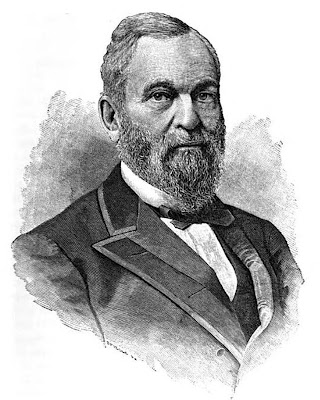Henry Wells and William Fargo FREE Images: March 18, 1850 – American Express is founded by Henry Wells (December 12, 1805 – December 10, 1878) and William Fargo (May 20, 1818 – August 3, 1881),.
Early in 1850, negotiations were entered into by Wells & Co., Livingston & Fargo, and Butterfield, Wasson & Co., for the consolidation of the three into one grand line. The result was, that the property and good will of Wells & Co. were put in at a valuation of $50,000, and those of Livingston & Fargo, at $50,000; Butterfield, Wasson & Co. put in theirs at $25,000, and made up the difference in cash. Two firms were then made of the three, viz.: "Wells, Butterfield & Co.," and "Livingston, Fargo & Co.," but comprised in a joint-stock concern, under the style of "The American Express Company." It was stipulated that this arrangement should last ten years. Henry Wells, then absent in Europe, was elected president of the new company, Wm. G. Fargo, of Buffalo, secretary; John Butterfield, of Utica, line superintendent; and Alexander Holland, of Schenectady, treasurer.
The latter (a son-in-law of John Butterfield) was appointed New York agent, and the duties of this important, responsible, and laborious office, as well as those of the treasuryship, he has discharged for several years past with excellent judgment and the most exemplary fidelity. It would be hard to find a more unselfish, true and manly person than Alexander Holland. T. B. Marsh was a very useful man in the Buffalo office. James C. Fargo was agent at Chicago, and general superintendent of the northwestern division. The Fargos are pre-eminently an Express family. Charles Fargo, the very popular agent and assistant superintendent at Detroit, in 1860, was the proprietor of the Lake Superior Express. Chas. S. Higgins, for some years general superintendent of the southwestern division, distinguished himself as an Express manager.
Other prominent and invaluable agents were W. B. Peck, at Buffalo; Dr. Arnett, at Suspension Bridge, A. Seymour, at Geneva; Major Doty, at Auburn; L. B. Van Dake, at Kochester, and Benedict, at Troy, N. Y.
In 1852, Henry Wells, Wm. G. Fargo and others, projected Wells, Fargo & Co.'s California Express, of which we shall speak more fully by and by. In that or the following year, Wells, Butterfield & Co. removed the New York office of the American Express to the spacious and convenient store No. 62 Broadway, where they remained until the completion of their edifice in Hudson street.
In the meantime, the bank exchanges performed by the company between St. Louis, Cincinnati, Chicago, Detroit, Buffalo, Albany, New York, and intermediate points, had become in itself an immense business. The parcel and freight Express, also, had increased a hundred fold within ten years.
This Image (or other media file) is in the public domain because its copyright has expired. This applies to the United States, where Works published prior to 1923 are copyright protected for a maximum of 75 years. See Circular 1 "COPYRIGHT BASICS" PDF from the U.S. Copyright Office. Works published before 1923 (in this case 1858) are now in the public domain.
TEXT and IMAGE CREDIT: History of the express companies: and the origin of American railroads, Together with some reminiscences of the latter days of the mail coach and baggage wagon business in the United States, Author: Alexander Lovett Stimson. Edition: 2. Publisher: A. L. Stimson, 1858, Length: 287 pages. Subjects: Express service Railroads. +sookie tex


No comments:
Post a Comment